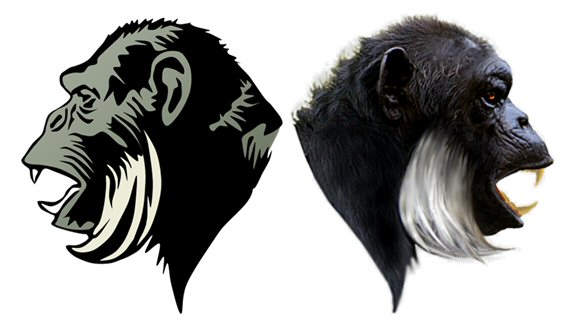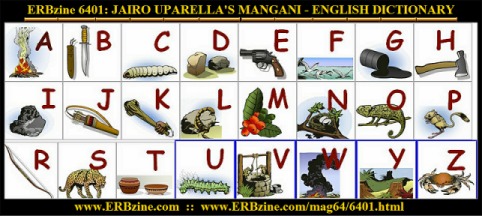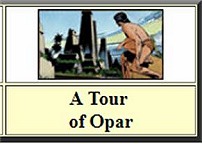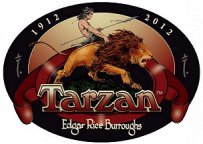
First and Only Weekly Online Fanzine Devoted to the Life & Works of Edgar Rice Burroughs
Since 1996 ~ Over 15,000 Web Pages in Archive
presents
Volume 2998
The Mangani species
by
Adriana Garavito Rozo and Jairo Uparella



Since 1912, when Edgar Rice Burroughs created the character of Tarzan, the Mangani have always been cause for concern for readers because scientifically species such as these, which according to the fiction have a great ability to learn better than their ancestors primitive but inferior to men, are seen as one of the possible closer relatives to the latter. It is sometimes said that the Mangani could be classified in traditional taxonomy as in the genus: Australopithecus, class: mammalian, order: primates or apes, family Pongidae or anthropomorphic and bipedal omnivores.
Although it is said to be an intermediate species between the chimpanzee and gorilla, it has characteristics of both other than their own. It also suggests that the average life of the Mangani is equal to that of man and shares 98% DNA similarity with them, according to tests made with the DNA hybridization technique, which many scientists consider a wrongdoing or error.
Some people say that the Mangani should be compared more with the Bili Ape or chimp giant, having many features in common, which highlights the findings of Edgar Rice Burroughs in his book Tarzan of the Apes.
Blending fiction with science and based on drawings provided by various comic artists, we have described below, from the standpoint of physical and behavioral, the Mangani's characteristics. We can then say, and by current scientific illustration that they are from genus: manganni (great-ape), family hominidae (great apes), phylum: chordata (spinal cord), class: mammalian, order: primates, superfamily: hominoidea (primate monkeys without tails).
Anatomical Characteristics
Their skin is usually dark as a gorilla. Their body is provided with a thin fur as located in the head and body, in colors as black, dark brown, gray and sometimes white. This coat is denser on the arms and legs, which helps them to not be readily identified among the bushes.
Their head is in the shape of an oval. The brain is smaller than the human's but larger than that of the chimpanzee. His skull bone as a whole is normally composed of a frontal bone, two parietal, two temporal and occipital. The face is more prominent, which makes their nasal septum long and narrow. They have delineated factions and their eyes can be brown, red or gray. Their ears are not very large. They have sharp teeth, both in the upper jaw and bottom, showing normal canines, incisors protruding molars and a set of considerable size, which makes their mouth prominent.
According to the pictures of Russ Manning, the cheeks are spacious and provided with locks of hair on each side from dark to clear color. This depends on the state of maturity, which also differentiates the largest youth Mangani, so also those who acquire more experience and learning.
His neck is short but muscular. The chest is broad with big pectorals. Their grasping hands and feet are large with flat nails and strong opposable fingers. As an adult, its weight ranges from 120-180 kilos (240-360 lbs), height of 1.60 to 2 meters (4.8 to 6 ft), but not this one special characteristic between males and females.
“Kerchak was a huge king ape, weighing perhaps three hundred and fifty pounds. His forehead was extremely low and receding, his eyes bloodshot, small and close set to his coarse, flat nose; his ears large and thin, but smaller than most of his kind.““In many ways did he (Tarzan) differ from them, and they often marveled at his superior cunning, but in strength and size he was deficient; for at ten the great anthropoids were fully grown, some of them towering over six feet in height, while little Tarzan was still but a half-grown boy."
The Mangani use front and rear limbs to move, the latter being a bit shorter, allowing them to move from branch to branch. In times of struggle or fight, they take an upright position. They are devoid of tail, so their spine is like the humans' ends. It differs from this in that cervical vertebrae form an arc extending from the spine, making the neck more voluptuous. The explanation for this is because their head is very heavy, leading to a slight forward body lean. The remaining vertebrae, thoracic and lumbar spine are spread, forming a solid. Overall, the column shows slight curvature characteristics of an ape, as the texture of muscle mass is greater, allowing it to bear more weight than the human, without losing his agility and elasticity. Their hip is more articulate than their ancestors enabling them to stand up and maintained maximum time span and walk in that position, though a bit unbalanced.
Characteristics of females
Seven years after birth, females are suitable for reproduction. They are over protective of their young which makes them excellent surrogate mothers. This stimulates and calms the babies for the sole contact or clinging to her body with their big arms, creating a bond of belonging, which is maintained until some time, as the young seek independence from an early age to prepare to become independent members of the tribe. Females have litters over a period of nine months with a calf on average, which from 6 months old, crawling and curious, they begin to feed on other products offered by nature and develop motor skills.
"Kala was the youngest mate of a male called Tublat, meaning broken nose, and the child she had seen dashed to death was her first; for she was but nine or ten years old.According to the story, Kala on one of her voyages lost her newborn baby who falls from many meters high. But she picks it up and continues to carry his arms against her chest along the path. When she hears the anguished cries of a human baby, Kala lightens her step and takes the little creature, exchanging it for her dead baby. By nature a female in this state of postpartum is subjected to various hormonal changes which bring about changes in her body, both in activity and daily interaction. Mangani females delayed a reasonable time to have babies, which should seek to normalize their body to protect the life of the newborn and its reproductive cycle. When this is disturbed, many females may die of sadness or even be rejected by the males.Notwithstanding her youth, she was large and powerful--a splendid, clean-limbed animal, with a round, high forehead, which denoted more intelligence than most of her kind possessed. So, also, she had a great capacity for mother love and mother sorrow.
But she was still an ape, a huge, fierce, terrible beast of a species closely allied to the gorilla, yet more intelligent; which, with the strength of their cousin, made her kind the most fearsome of those awe-inspiring progenitors of man."
This is why Kala welcomes Tarzan instinctively, though not being of the same species, has the weight, movement and care needs similar to those demanded by her son.
"High up among the branches of a mighty tree she hugged the shrieking infant to her bosom, and soon the instinct that was as dominant in this fierce female as it had been in the breast of his tender and beautiful mother - the instinct of mother love - reached out to the tiny man-child's half-formed understanding, and I became quiet. "
Psychological characteristics and their habitat
As in all species of apes, learning is based on imitation, mimicking what others do, but with the tendency to explore and reason as in humans.
Unlike the other animals, Mangani developed an ability to solve problems in certain situations, being able to call this "an intelligent behavior." They are instinctive, receive sensations and associated images; they are not reflective about their actions, making them use this “intelligence” for useful or harmful purpose. The development of this behavior occurs depending on their biological heritage and the environment where they have developed or live (West Africa, overlooking the plain and the coast), which is why Mangani are divided into two groups according to the phylogenetic order:
1. Those located in rugged and remote places. (Manganni Celsus Petra). They live in high places, where there are rocky caves. Their temperament is aggressive, they are noisy, and they seem in a bad mood. Their union is complicity to harm or kill and face everything. Their loyalty is based on a survival mechanism because even if they are found in groups, are independent. They are excellent hunters with ability to observe and monitor, and see the opportunity to descend upon their prey.
2. Those living among trees in the rainforest. (Manganni Arboreous). It is the largest group, remain hidden, are stable groups of many members, up to 70 individuals, but their union does not allow disintegration. Their daily activity is to go looking for food and shelter. Usually his temperament is gentle, but when something upsets them they beat their chests, show their teeth and throw whatever is around them very aggressively."The tribe of anthropoids over which Kerchak ruled with an iron hand and bared fangs, numbered some six or eight families, each family consisting of an adult male with his females and their young, numbering in all some sixty or seventy apes."
Psychologically the Mangani reached a better evolution -- unlike other apes, since apparently in ancient times they had contact with man. Around them there were human tribes which had to defend and attack. For many years, the Mangani could have observed and imitated them in their daily activities as in the case of tools used for food. There were also specialized tools for defense and hunting, gait, security, defense and attack, hitting logs at night in the rituals or issuing sounds every full moon. Their natural psychology is based on the repetition of experiences which have provided them a unique identity as a species."They traveled for the most part upon the ground, where it was open, following the path of the great elephants whose comings and goings break the only roads through those tangled mazes of bush, vine, creeper, and tree. When they walked it was with a rolling, awkward motion, placing the knuckles of their closed hands upon the ground and swinging their ungainly bodies forward. But when the way was through the lower trees they moved more swiftly, swinging from branch to branch with the agility of their smaller cousins, the monkeys."The Mangani do not have not a religion per se, but follow many doctrines and commands which allow them to live in society and think about their preservation. We could say that it is not a religion based on the mythological aspect but one which explains the phenomena of nature, which is taken for their own benefit, as the light of the moon and hunting rituals, rain as a sign to take advantage of food, sun for nourishment, and many more that are not associated with luck, omens, superstition or offerings such as followed by humans. Death for the Mangani is synonymous with old age, defeat in war or disease. They are not afraid of death, they don't cling to life and there’s no lengthy ritual for the eventual death of a member.
"From this primitive function has arisen, unquestionably, all the forms and ceremonials of modern church and state, for through all the countless ages, back beyond the uttermost ramparts of a dawning humanity our fierce, hairy forebears danced out the rites of the Dum-Dum to the sound of their earthen drums, beneath the bright light of a tropical moon in the depth of a mighty jungle which stands unchanged today as it stood on that long forgotten night in the dim, unthinkable vistas of the long dead past when our first shaggy ancestor swung from a swaying bough and dropped lightly upon the soft turf of the first meeting place.""The rites of the Dum-Dum marked important events in the life of the tribe--a victory, the capture of a prisoner, the killing of some large fierce denizen of the jungle, the death or accession of a king, and were conducted with set ceremonialism."
Social Life
The Mangani are hierarchical and gregarious, which leads them to learn certain social norms and limits by way of discipline. Their form of interaction is the game and learning. Whoever takes the command is a dominant male (King) who directs and gives its name to the tribe. In the hierarchy he is followed by older females, young adults and teenagers eventually. This means that they respect each other for age and experience, but not by force. But in some cases, this has its exception, especially when the life of one of the leading members is at stake.
Rarely, they are organized militarily for security, despite the hierarchy they follow, which indicates that the principle is not the conquest or protection of land, but life in society."Kerchak’s awful temper and his mighty strength made him supreme among the little tribe into which he had been born some twenty years before. Now that he was in his prime, there was no simian in all the mighty forest through which he roved that dared contest his right to rule, nor did the other and larger animals molest him."
Food, tools and hunting
The Mangani are omnivorous, meaning they feed on everything they find or hunt. Generally feed on bark, shoots and leaves, which is a contribution to their nutrition, moderately high in fiber, which is easily tolerated because of their specialized stomach, although often chew food before digesting them. The juicy fruits are highly palatable -- provide fluids, some fiber, vitamins and sugars. Supplement their diet with foods rich in animal protein, with a variety of mammals, reptiles, birds and fish. Insects (ants and termites) and worms are like candy to supplement their diet."The young played and frolicked about among the trees and bushes. Some of the adults lay prone upon the soft mat of dead and decaying vegetation which covered the ground, while others turned over pieces of fallen branches and clods of earth in search of the small bugs and reptiles which formed a part of their food. Others, again, searched the surrounding trees for fruit, nuts, small birds, and eggs."For their food, the Mangani developed a number of positions and tools according to their needs.Those who live in the cliffs and caves are less mobile but require more time to look for food, because they are located in strategic places (visible and high) where they sit, wait and watch. Because of their proximity to waterfalls and valleys, they can select and capture a wide variety of animals. To hunt large animals such as mammals, they form a group and surround them. They then use thick sticks and prepared stones (sliced) to immobilize them, hitting them again and again or sometimes by strangulating them. They drag them down and with the help of their powerful teeth they tear the flesh, taking the portion they wish.
For fishing, they approach the water's edge looking for low spots, where they can fish with ease. Their skill is such that they sometimes capture them by hand, sometimes even reaching into the water from tree branches.
As a tool, they use woody stems, with a pointed end, similar to a sharp spear, and with some skill and aiming they successfully catch fish.
When meat is part of the diet, as in this group, they supplement it with a variety of juicy and tender foliage, because the fruits are not readily available.
In the place where they live are abundant flightless bird nests, so that eggs are a good food.
Among the dry dead tree trunks, they hunt small invertebrates with aid of long poles, thin or hollow. They use these poles to suck up larvae and worms or to lick off ants and termites that adhere to them. But their main eating tools are their fingers and toes, which they use with great ability.
With regard to the group living in wild places, they base their diet on fruits, stems, insects, mammals and fish. Their tools are not as elaborate but equally functional as there is a wide variety of food on hand. They prefer land birds because they are easy to catch in the bushes. Here they use large sticks to immobilize them. Hunting for them is not necessarily a preplanned physical or mental effort, rather an action that conforms to what they find on the road. They cover large areas in searching for food, so this task takes between 8-10 hours per day.
"The tribe to which he belonged roamed a tract extending, roughly, twenty-five miles along the seacoast and some fifty miles inland. This they traversed almost continually, occasionally remaining for months in one locality; but as they moved through the trees with great speed they often covered the territory in a very few days. Much depended upon food supply, climatic conditions, and the prevalence of animals of the more dangerous species; though Kerchak often led them on long marches for no other reason than that he had tired of remaining in the same place."
Nests
Mangani of the rocks prefer caves to make their nests which protect them from wind and rain. The nests are made with mounds of earth and dry leaves used as a cushion.Mangani of the other group, make their nests on platforms of branches in trees, 6-8 feet high, or in some cases on the ground, using leaves collected around them.
"At night they slept where darkness overtook them, lying upon the ground, and sometimes covering their heads, and more seldom their bodies, with the great leaves of the elephant's ear"
Communication
Although Mangani are noiseless, they emit particular sounds, which are a sign of recognition that guarantees their survival in the jungle. Their ability to communicate is based on guttural sounds that are manifestations according to their feelings (bad mood, anger, fear, desire, love, hunger, trial, etc.). Generally they produce many gestures that, unlike those of other apes, can be associated with a nearly human interpretation.However, the Mangani have developed the ability to understand a lot of short and strong human words, images and sensations associated with time and space by repetitive method, whose capacity determined the importance of this form of communication as a language known as the Language of the Great Apes.
The coexistence of the Mangani with human beings such as Tarzan was more developed than that of previous generations because they acquired an almost human sagacity raising them to a certain level of behavior. While it is true that Tarzan was in search of their identity, his human intelligence caused him to be respectful, noble and fair to the conduct and principles of a more primitive group. These individuals, of different species, welcomed him in the same way to be part of this great family called Mangani.

Tarzan
Wild WeaponsThe
Mangani SpeciesThe
WaziriRon Ely's
Intro AnimationHero of
the AmazonThe Real Art
Behind the Comic

MANGANI LANGUAGE
An ERB
Researcher
Just a Tarzan Fan
by
Jairo Uparella
ERBzine 2114Investigating
Mangani
An Introduction
Prelude to the
Mangani Project
ERBzine 2112The Uparella
Mangani Project
ERB Ape
Language
Dictionaries
ERBzine 2113Mangani
Grammar
by
Jairo Uparella
ERBzine 3560The Sounds of
Spoken Mangani
by Jairo Uparella
ERBzine 2307

ERBzine 2113 |

Bili_Ape |

ardipithecus |

Australopithecus |

Adriana y Jairo Uparella |
Columbia's ERB Researcher Articles in ERBzine Just a Tarzan Fan Hero of the Amazon Tarzan Wild Weapons |

Jairo's e-Zine |

![]()

![]()
BILL
HILLMAN
Visit
our thousands of other sites at:
BILL
and SUE-ON HILLMAN ECLECTIC STUDIO
ERB
Text, ERB Images and Tarzan® are ©Edgar Rice Burroughs, Inc.-
All Rights Reserved.
All
Original Work ©1996-2010/2019 by Bill Hillman and/or Contributing
Authors/Owners
No
part of this web site may be reproduced without permission from the respective
owners.